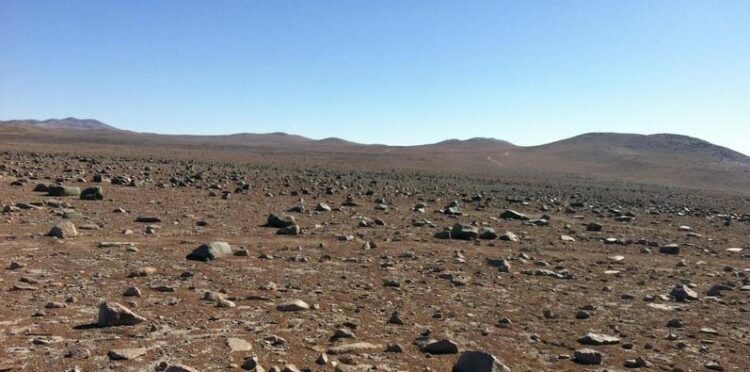Microbes and viruses – a threat to Mars?

Microbes and viruses: Prof. Alexander Probst's international team took samples from under these rocks in the Atacama Desert.
© Dirk Schulze-Makuch
International Study…
Viruses are survivors! Desert heat and desiccation can’t harm some of them. „We find viruses and microbes in the driest and most radiation-intensive, non-polar region on Earth, which is really amazing,“ says Prof. Dr. Alexander J. Probst from the Environmental Biology and Biotechnology Department at the University of Duisburg-Essen (UDE). An international team led by Probst discovered the viruses and microorganisms in the Atacama Desert. This has been published in the journals „mSystems“ * and „Microbiome“ **.
The Atacama Desert stretches along Chile’s Pacific coast over 100,000 square kilometres. It is one of the most arid places in the world. Annual precipitation averages 0.5 mm, which is less than for the Death Valley in California.
„We found very specific microbes called Archaea to dominate the driest parts of the Atacama – which goes beyond our current knowledge,“ says microbiologist Probst. More precisely, the researchers came across ammonia oxidizing archaea that have developed numerous resistances. They occur under rock-covered parts of the desert, where they are protected from UV radiation. The boulder fields cover up to a quarter of the hyperarid core of the Atacama Desert. Nobody had considered the soil beneath the boulders as a special habitat.
„We also found viruses in the desert that infected bacteria and spread over 200 km,“ the UDE scientist reports. For space travel, he says, this finding is quite important. „The Atacama Desert is considered a Mars analog.“ When terrestrial life hitchhikes on a spacecraft to the red planet, it probably spreads widely, as the viruses’ dispersal patterns showed. In addition, he said, there could be possible zones of life under Martian rocks, just as they are in the Atacama despite desiccation. „The findings bolster our understanding of deserts in terms of carbon and nitrogen turnover. Because of climate change, after all, deserts are continuousl expanding.“
Researchers from the TU Berlin, Duisburg-Essen, the German Research Center for Geosciences (GFZ), Helmholtz Zentrum München, the Leibniz Institute of Freshwater Ecology and Inland Fisheries, and the U.S. universities of Harvard (Cambridge) and Rhode Island, Kingston contributed to the study.
For the editors:
A photo of rocks in the Atacama Desert (© Dirk Schulze-Makuch) is available for your reporting under the following link:
https://www.uni-due.de/imperia/md/images/pool-ps/downloads/2021-11-30_hyperaridc…
Further information:
Prof. Dr. Alexander J. Probst, FG Aquatic Microbial Ecology, phone +49 (0)201/18 3-7080, alexander.probst@uni-due.de
Editor: Alexandra Niessen, phone +49 (0)203/37 9-1487, alexandra.niessen@uni-due.de
Wissenschaftliche Ansprechpartner:
University Duisburg-Essen, FG Aquatic Microbial Ecology, Prof. Dr. Alexander J. Probst, phone +49 (0)201/18 3-7080, alexander.probst@uni-due.de
Originalpublikation:
* Y. Hwang, J. Rahlff, D. Schulze-Makuch, M. Schloter, A. J. Probst: „Diverse Viruses Carrying Genes for Microbial Extremotolerance in the Atacama Desert Hyperarid Soil“, MSystems 6 (18.5.2021), https://doi.org/10.1128/mSystems.00385-21
** Y. Hwang, D. Schulze-Makuch, F. L. Arens, J. S. Saenz, P. S. Adam, Ch. Sager, T. L. V. Bornemann, W. Zhao, A. Airo, M. Schloter, A. J. Probst: „Leave no stone unturned: Individually adapted xerotolerant Thaumarchaeota sheltered below the boulders of the Atacama Desert hyperarid core“, Microbiome 9, 234 (26.11.2021):
https://doi.org/10.1186/s40168-021-01177-9 and https://microbiomejournal.biomedcentral.com/articles/10.1186/s40168-021-01177-9
Media Contact
All latest news from the category: Life Sciences and Chemistry
Articles and reports from the Life Sciences and chemistry area deal with applied and basic research into modern biology, chemistry and human medicine.
Valuable information can be found on a range of life sciences fields including bacteriology, biochemistry, bionics, bioinformatics, biophysics, biotechnology, genetics, geobotany, human biology, marine biology, microbiology, molecular biology, cellular biology, zoology, bioinorganic chemistry, microchemistry and environmental chemistry.
Newest articles

Silicon Carbide Innovation Alliance to drive industrial-scale semiconductor work
Known for its ability to withstand extreme environments and high voltages, silicon carbide (SiC) is a semiconducting material made up of silicon and carbon atoms arranged into crystals that is…

New SPECT/CT technique shows impressive biomarker identification
…offers increased access for prostate cancer patients. A novel SPECT/CT acquisition method can accurately detect radiopharmaceutical biodistribution in a convenient manner for prostate cancer patients, opening the door for more…

How 3D printers can give robots a soft touch
Soft skin coverings and touch sensors have emerged as a promising feature for robots that are both safer and more intuitive for human interaction, but they are expensive and difficult…





















